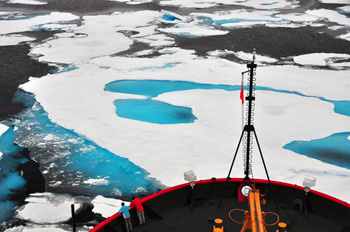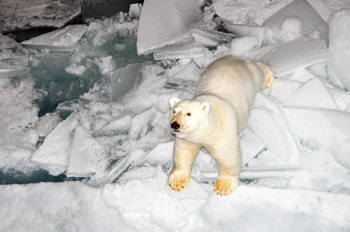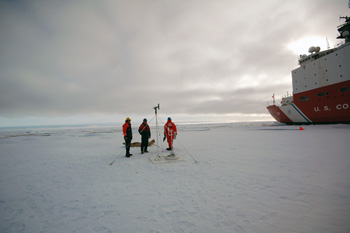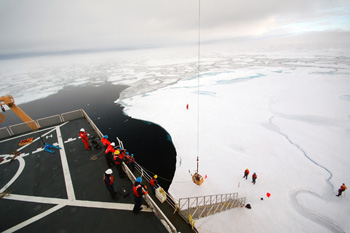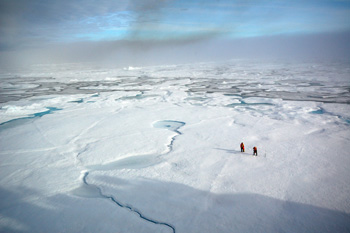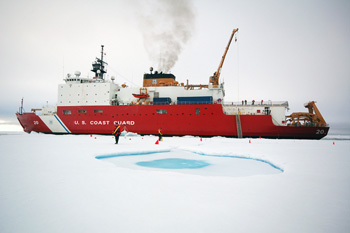September 18thIt’s 0630 on the bridge. Under low, dun clouds, broken floes pocked with turquoise melt ponds cover the ocean from horizon to horizon, intricate, unduplicated patterns of cracks and fissures laced with aquamarine strips of open water. Dr. Bob is up here, so are Captain Rall, John and Frank and the bridge watch searching for a floe to accommodate the met station. Meanwhile, the rest of us, excited, less businesslike, talk animatedly about the wild, hostile environment—and about the polar bear seen at 0400 perusing the ship close aboard. Top predator, utterly unwary of this big red thing in his world, he ambled aft watching, apparently considering bounding aboard to see what’s in it for him.
The ship trembles stem to stern. Thuds, cracks, clanks, and hollow thunks reverberate through hull and decks as Healy shoulders aside meter-thick floes the size of tennis courts. Alarming at first, these are not noises you’re supposed to hear on a ship; sounds too much like grounding, feels a little like it too. Here’s a very big one. She doesn’t make it through, stops, backs, and rams the floe, engines revving, hull throbbing, and the ice gives in, cracking down the middle. “Bear,” someone calls from the starboard bridge wing. There are two away about 200 yards. We can’t tell if they’re juvenile males or a mother and a maturing cub. But lacking any freeboard, none of these floes is adequate for our purposes, so we press on past 73 degrees North searching for something high, solid, and predictably permanent. "If you fall through the ice, don't wait for us to get there." -BM3 Kimmel It’s 1000 now, and the icebreaking noise has suddenly ceased. Did they find something?... Yes, the ship is backing, maneuvering into position to stick the bow against a floe slightly smaller than a city block with a gentle hillock and a big blue-ice melt-water pond. Intercom: “There will be an ice-deployment meeting on the bridge in five minutes.” Then repeated. All announcements are repeated. I’m hoping to help John and Frank attach the met station to the ice so I can report on the scene, but they really don’t need me. I’m liable to be cut from the team. But I’m going to the bridge meeting as if I were essential personnel until someone points out that I’m not.
Marine Science Technician Lee Brittle outlines the plan. The gangplank (they call it the “brow”) will be deployed from the port quarter. There will be one man stationed on the flight deck with a rifle—bear watch—and two rescue swimmers will go over first to drill test holes to make certain the ice is at least 18 inches thick. They will then mark out a safe perimeter with red flags and traffic cones. The science team will go out next. Their equipment, hand tools, gas-powered ice auger, and the met station itself will be delivered to the ice by crane. And then the photographers, Rachael and Ben, will go out on the ice. The photographers will be accompanied at all times by a rescue swimmer, because you know how photographers are—they can walk backwards concentrating on the shot and fall in the drink. He checked off each item on his clipboard. “Three bears have been sighted in the area,” said the Captain. “So break out the shotgun as well. The signal for bear emergency will be the ship’s whistle or flight-crash horn. If you hear that, abandon your gear and get back to the ship.” (There’s a story going around about a science team that had to flee the ice when a polar bear came along and, finding all that neat, shiny gear, playfully kicked it around reducing it to trash while the chief scientist watched with what, one supposes, were very mixed emotions. But bears will be shot only to save a human life.) The head rescue swimmer, BM3 Kimmel briefed us: “If you fall through the ice, don’t wait for us to get there. Try to get yourself out. The Mustang suits will keep you afloat, kick your feet, and try to climb out on your elbows.” “We’re not going to anchor the ship to the ice, so the shafts will be turning,” said the Captain to the safety team. “Notice vibration on the ice. Sometimes the vibration can crack it.” This was serious business. We liked that. “After we complete the science, we’ll see about the ice and the visibility, then decide about ice liberty for the crew.”
Things got underway right after lunch. The crew craned the brow overboard, fixing the inboard end on the 01 deck at a steep angle down to the ice, and the safety team began drilling test holes. Frank and John lashed the disassembled met station and the power augur into a big plywood box while I stood around looking for ways to be invaluable, and the crane lowered it to the ice. Meanwhile, the heavily armed bear watchman scanned the middle distance through binocs from the flight deck. John and Frank made their way down the ramp while I brought up the rear. The ice, covered by a thin layer of corn snow, felt as sold as Broadway. John had chosen a spot on the slight rise. He fired up the power augur to drill a base hole for the battery pack, GPS receiver, and various electronics. (This guy John Kemp, considered the best mooring technician on the planet, can do anything and make it look easy.) He drilled another hole to support the upright on which the anemometer and other sensors are mounted. We lashed it in place with ice screws and guy lines, while Ben and Rachel were shooting the scene. This was all going very smoothly and quickly. I realized I had time to remind myself that we were actually working in the Arctic on a frozen patch of the Beaufort Sea and that it was utterly beautiful out here, sun glinting on the ice, contrasting smoky clouds hanging low over the horizon, this massive red-hulled ship in the foreground perfectly consistent with and suited to her environment. Intercom: “Ice liberty will commence at 1430.” Crew and science staff made their way one by one down the brow onto the Beaufort Sea, perhaps 100 people. Everyone was smiling. Last updated: September 28, 2010 | |||||||||||||||||||||||||
Copyright ©2007 Woods Hole Oceanographic Institution, All Rights Reserved, Privacy Policy. | |||||||||||||||||||||||||
